How to Find the Ideal AI Chatbot for Your eCommerce Platform in 2025
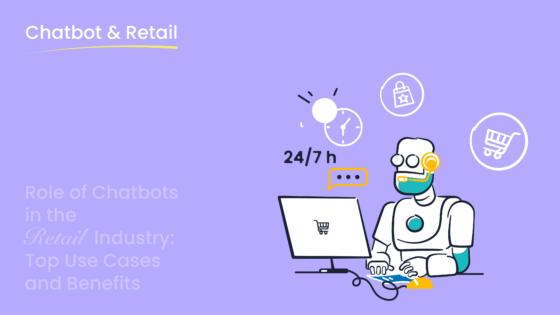
Imagine running an online store where customers get answers instantly, no matter the time. That’s the power of the right ecommerce ai chatbot. It’s more than a tool—it’s your partner in delivering top-notch customer service. With chatbots capable of handling 79% of routine queries and saving businesses 30% on support costs, they’ve become essential. The global chatbot market is booming, expected to hit $27.3 billion by 2030.

In 2025, aligning chatbot features with your business goals isn’t optional—it’s a must. Customers expect personalized, 24/7 support. Companies like Sobot are leading the way, offering solutions that integrate seamlessly and enhance user experiences. The result? Happier customers and stronger sales.
Define Your Business Needs for an Ecommerce AI Chatbot
Choosing the right ecommerce AI chatbot starts with understanding your business needs. Without a clear roadmap, you risk investing in a tool that doesn’t align with your goals or your audience’s expectations. Let’s break this down step by step.
Identify Your Goals for Customer Service and Sales
What do you want your chatbot to achieve? This question is the foundation of your decision-making process. Whether you’re aiming to improve customer service, boost sales, or both, defining your goals will guide you toward the right solution.
Start by analyzing your current operations. Are customers facing long wait times for support? Do you struggle to convert website visitors into buyers? These pain points can help you pinpoint areas where a chatbot can make a difference. For example, chatbots can handle routine queries, freeing up your team to focus on complex issues. They can also proactively engage visitors, nudging them toward completing purchases.
To set clear goals, follow these proven methodologies:
- Gather data from your sales reports, CRM systems, and customer feedback.
- Analyze patterns in customer behavior, sales trends, and market conditions.
- Define specific, measurable, achievable, realistic, and time-bound (SMART) goals.
- Develop a plan to address obstacles and implement strategies.
- Monitor progress and adjust your approach as needed.
Here’s a table of metrics to help you measure your chatbot’s success:
| Metric | Description |
|---|---|
| Goal completion rate | Measures the percentage of interactions that achieve a specific goal set for the chatbot. |
| Fallback rate | Indicates how often users need to be redirected to human agents, reflecting chatbot effectiveness. |
| Self-service rate | Shows the frequency of users completing their queries without human intervention. |
| Conversation starter messages | Tracks how often the chatbot successfully initiates conversations with users. |
| Chat volume | Counts the number of interactions initiated by users, indicating engagement levels. |
| Conversation duration | Measures the length of conversations, which can indicate user engagement or potential issues. |
| Return on investment (ROI) | Evaluates the financial return from the chatbot compared to its costs. |
| Leads generated | Counts the number of high-quality leads captured by the chatbot. |
| Bounce rate | Measures the percentage of users who leave without interacting with the chatbot. |
| Click-through rate | Indicates how many users engage with promotional content shared by the chatbot. |
| Conversion rate | Measures the percentage of users who complete a purchase through the chatbot interface. |
| Abandonment rate | Tracks how many users start but do not complete a purchase process initiated by the chatbot. |
By focusing on these metrics, you can ensure your chatbot aligns with your ecommerce business goals and delivers measurable results.
Understand Your Audience and Their Preferences
Your audience is the heart of your ecommerce business. If your chatbot doesn’t resonate with them, it won’t succeed. Understanding their preferences is key to creating an engaging experience.
Start by asking yourself: Who are your customers? Are they tech-savvy millennials or older generations who prefer simplicity? Do they speak multiple languages? Knowing these details helps you tailor your chatbot’s design and functionality.
Statistics reveal some interesting trends about audience preferences for ecommerce AI chatbots:
| Statistic | Value | Description |
|---|---|---|
| 70% | More customers interact with engaging chatbots | Businesses that provide high-quality chatbot experiences see a significant increase in customer interaction. |
| 36% | Businesses using chatbots for lead generation | A notable percentage of businesses leverage chatbots to enhance their lead generation strategies. |
| 64% | Customized support experience | A majority of businesses believe chatbots enable them to offer a more personalized support experience. |
| 39% | Chats involving chatbots | A significant portion of all business-consumer chats are conducted via chatbots. |
| 25% | Primary support channel by 2027 | By 2027, chatbots are expected to become the main customer support channel for a quarter of businesses. |
| $300,000 | Average savings per year | Businesses utilizing chatbots save a substantial amount annually. |
| 96% | Consumer awareness of chatbots | A vast majority of consumers are aware of chatbots and their functionalities. |
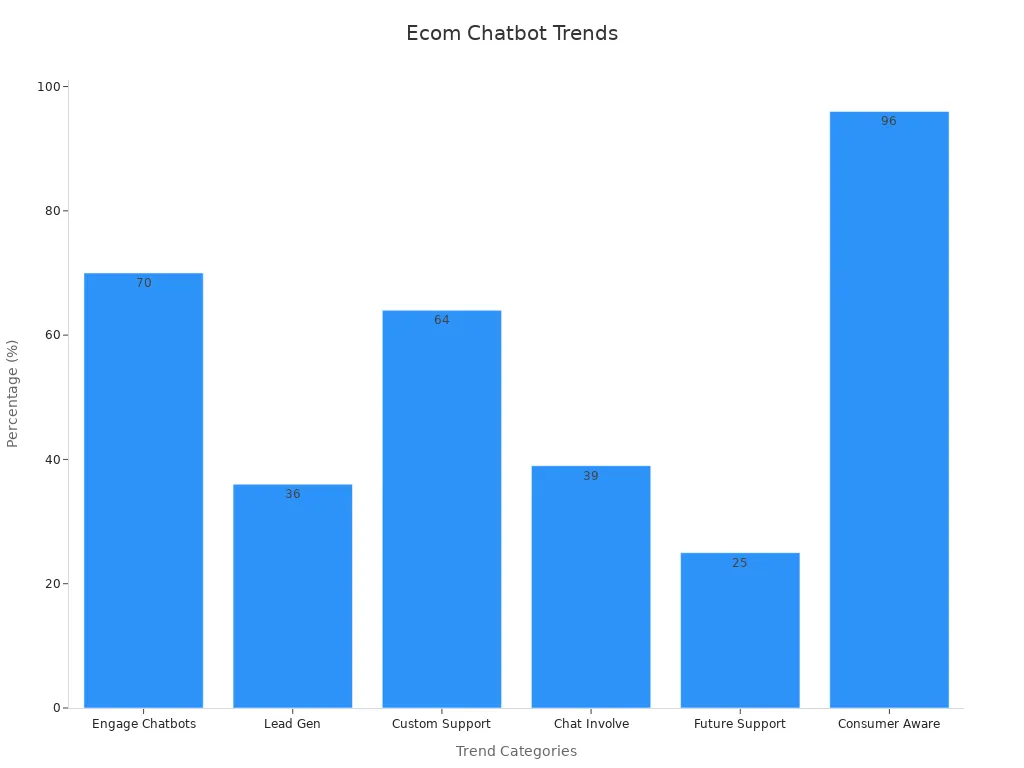
These insights highlight the importance of offering personalized, multilingual, and intuitive chatbot experiences. For example, if 70% of customers prefer engaging chatbots, yours should be designed to initiate meaningful conversations. Similarly, multilingual support can help you connect with a global audience, while proactive messaging can reduce cart abandonment rates.
Understanding your audience isn’t just about demographics—it’s about anticipating their needs and preferences. When you know what they want, you can choose the right platforms and features to deliver an exceptional experience.
Key Features to Look for in an AI Chatbot
When choosing an AI chatbot for your eCommerce platform, you need to focus on features that directly impact customer satisfaction and business growth. Let’s explore the must-have capabilities that can transform your chatbot into a powerful tool for your online store.
Natural Language Processing for Better Conversations
Imagine a chatbot that understands your customers as if it were human. That’s the magic of Natural Language Processing (NLP). With NLP, your chatbot can recognize customer inquiries in natural language, making interactions smoother and more intuitive. It’s not just about answering questions—it’s about understanding intent, tone, and context.
Advanced NLP techniques like intent classification, named entity recognition, and sentiment analysis take chatbot conversations to the next level. For example, if a customer asks, “Do you have this in blue?” your chatbot can identify the product, check inventory, and respond instantly. This reduces fallback rates and boosts user satisfaction.
Studies show that NLP-powered chatbots outperform traditional rule-based systems. They achieve higher intent understanding accuracy, better query resolution rates, and improved conversation quality. These metrics translate into happier customers and stronger engagement.
Tip: Look for chatbots that use dialogue management to maintain conversational flow. This ensures your customers feel heard and valued throughout their interaction.
Multilingual Support for Global Reach
Your eCommerce platform likely attracts customers from all over the world. Without multilingual support, you could miss out on a huge chunk of potential buyers. A chatbot that speaks your customers’ language is essential for building trust and driving sales.
Statistics reveal that over 50% of eCommerce traffic comes from international sources. If your chatbot doesn’t offer multilingual capabilities, you risk losing 40% or more of potential customers. Additionally, 57% of consumers prefer shopping on websites in their native language, and 73% prioritize product reviews in their language. These numbers highlight the importance of catering to diverse linguistic needs.
A multilingual chatbot doesn’t just translate—it adapts to cultural nuances and preferences. For instance, it can provide localized product recommendations or tailor promotions to specific regions. This creates a personalized experience that resonates with global audiences.
Note: Choose a chatbot that supports multiple languages and integrates seamlessly with your platform. This ensures consistent service quality across borders.
Personalization to Increase Online Conversion
Personalization is the secret sauce for boosting conversion rates. Customers love feeling like the experience was designed just for them. An AI chatbot with personalization capabilities can deliver tailored product recommendations, targeted promotions, and customized support.
Here’s the impact personalization can have on your eCommerce business:
- Segmented marketing campaigns based on customer data can increase conversion rates by 50%.
- Behavioral data-driven ads and personalized content can lead to a 10% boost in conversions.
- Personalized product recommendations can skyrocket conversion rates by 288%.
Imagine a customer browsing your store. Your chatbot notices they’ve been looking at sneakers and suggests a matching pair of socks. That small touch can make all the difference in closing the sale. Personalization doesn’t just increase conversion rates—it builds loyalty and trust.
Pro Tip: Opt for a chatbot that uses AI capabilities to analyze customer behavior and preferences. This ensures your recommendations are always relevant and impactful.
Integration and Compatibility with Ecommerce Platforms
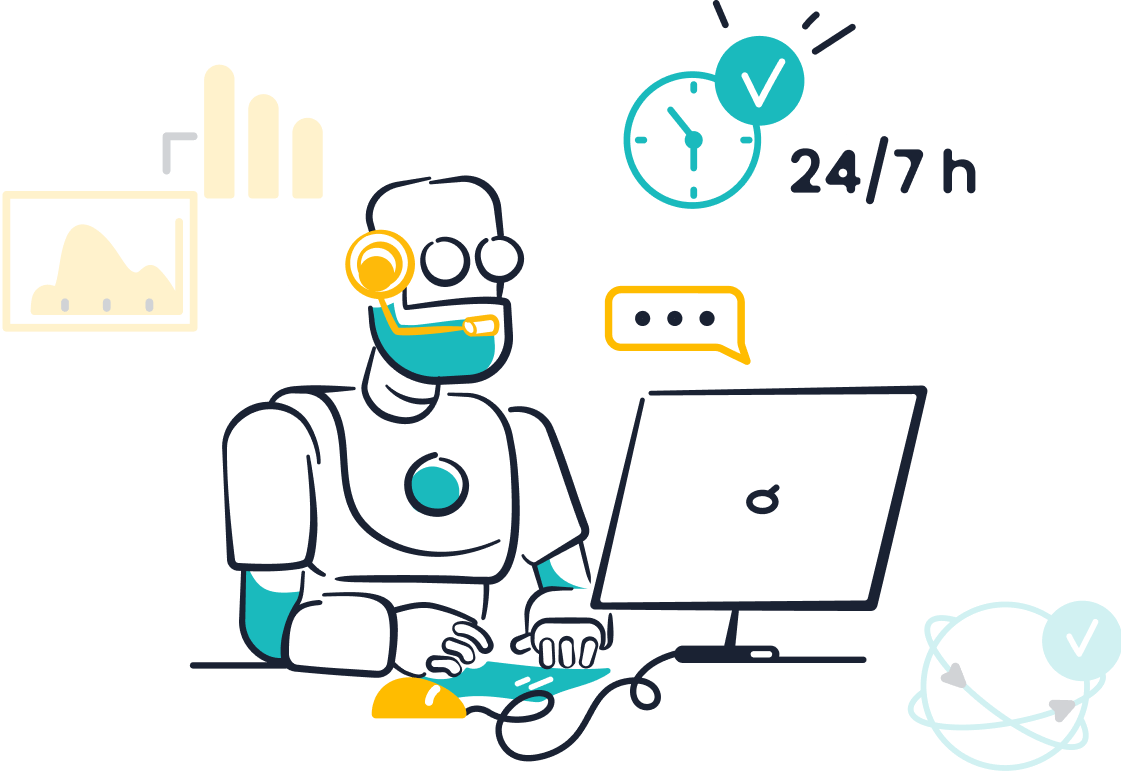
When choosing an AI chatbot for your eCommerce platform, integration is a critical factor. A chatbot that doesn’t work well with your existing systems or tools can create more problems than it solves. Let’s explore how seamless integration and API compatibility can make your chatbot a perfect fit for your business.
Seamless Integration with Existing Systems
Your eCommerce platform already has tools and systems in place, like inventory management, order tracking, and customer relationship management (CRM). A chatbot should connect effortlessly with these systems to provide a unified experience. This ensures your chatbot can access real-time data, like inventory levels or order statuses, to assist customers instantly.
For example, many AI chatbots integrate smoothly with platforms like Shopify, Magento, or WooCommerce. This allows them to pull live inventory data or update order details without manual intervention. Advanced algorithms, such as natural language processing (NLP) and machine learning (ML), enable chatbots to handle customer queries in real time. However, rigorous testing is essential to ensure the chatbot works flawlessly with your platform.
The benefits of seamless integration go beyond functionality. Businesses like Mavi have seen a 12x return on investment by integrating chatbots for personalized customer engagement. Similarly, Skinny Mixes increased revenue by 20% and recovered 19% of abandoned carts using chatbot automation. These examples highlight how integration can directly impact your bottom line.
Tip: Before choosing a chatbot, check if it supports your eCommerce platform and existing tools. This will save you time and headaches during implementation.
API and Third-Party Tool Compatibility
APIs (Application Programming Interfaces) are the backbone of modern software integration. They allow your chatbot to communicate with third-party tools, making it more versatile and efficient. Whether it’s connecting to a payment gateway, a marketing tool, or a shipping service, API compatibility ensures your chatbot can handle complex tasks seamlessly.
Metrics like uptime and API efficiency are crucial for evaluating compatibility. For instance, uptime measures how reliable the API is, while "Time to First Hello World" (TTFHW) reflects how quickly developers can implement the API. A well-designed API minimizes the number of calls needed for a transaction, making your chatbot faster and more flexible.
| Metric | Description |
|---|---|
| Uptime | Tracks service availability, ensuring minimal downtime. |
| Time to First Hello World (TTFHW) | Measures how quickly developers can implement the API. |
| API Calls per Business Transaction | Indicates the efficiency of the API design, with fewer calls being better. |
| Business/Growth Metrics | Focuses on revenue, adoption, and customer success, showing the API's impact on business growth. |
By choosing a chatbot with robust API compatibility, you can unlock new possibilities for automation and customer engagement. This flexibility allows your business to adapt and grow without being held back by technical limitations.
Note: Always evaluate the API documentation and support provided by the chatbot vendor. Clear documentation can make integration much smoother.
Budget and ROI Considerations for AI Chatbots
Balancing Costs with Expected Benefits
Investing in an AI chatbot might seem like a big step, but the benefits often outweigh the costs. You’re not just buying a tool—you’re unlocking long-term savings and efficiency. Here’s how chatbots balance costs with their expected benefits:
- They reduce operational costs by up to 40% through automation. Tasks like inventory updates and multilingual customer support no longer need human intervention.
- Pre-trained bots save setup time, allowing you to see returns faster.
- Chatbots handle simple queries, cutting the need for extra customer service agents.
Think of it this way: while the initial investment might feel steep, the savings on labor and operational expenses quickly add up. Plus, chatbots work 24/7, ensuring your customers always get the support they need.
When evaluating costs, consider the scalability of the chatbot. As your business grows, a well-designed chatbot can adapt without requiring significant upgrades. This flexibility makes it a cost-effective solution for businesses of all sizes.
Tip: Look for chatbots that offer customizable plans. This way, you can start small and scale as your needs evolve.
Measuring ROI in Terms of Sales and Customer Satisfaction
How do you know if your chatbot is worth the investment? Measuring ROI is the key. You can track its impact on sales and customer satisfaction using specific metrics.
| Metric | Description |
|---|---|
| Query Resolution Rate | Percentage of inquiries resolved by the chatbot. |
| First Response Time | Speed of the chatbot's initial reply to user queries. |
| Cost per Interaction | Cost associated with each interaction with the chatbot. |
| Automation Rate | Percentage of tasks completed without human intervention. |
| Query Volume Handled | Total number of queries managed by the chatbot. |
| Implementation and Maintenance Costs | Total investment in the chatbot system. |
| Labor Cost Reduction | Savings from reduced human support due to chatbot usage. |
| Revenue Generated | Income from chatbot-driven sales or recommendations. |
| Customer Satisfaction Score (CSAT) | Measures customer happiness post-interaction. |
| Net Promoter Score (NPS) | Indicates long-term customer loyalty. |
| First Contact Resolution Rate | Frequency of issues resolved without human support. |
| Customer Retention Rate | Links chatbot efficiency to customer loyalty. |
For example, if your chatbot resolves 80% of queries without human help, that’s a clear sign of efficiency. Similarly, tracking revenue generated from chatbot-driven recommendations shows its impact on sales.
Customer satisfaction metrics like CSAT and NPS reveal how well your chatbot enhances the overall experience. A high CSAT score means your customers are happy, while a strong NPS indicates they’re likely to recommend your business.
Note: Regularly review these metrics to ensure your chatbot continues delivering value. Adjust its features or training as needed to maximize ROI.
Enhancing Customer Experience with AI Chatbots

User-Friendly Design for Intuitive Interactions
A chatbot should feel like a helpful assistant, not a frustrating obstacle. That’s why user-friendly design is so important. When your customers interact with a chatbot, they expect quick, clear, and easy-to-understand responses. If the design is confusing or clunky, they’ll leave feeling frustrated.
To create intuitive interactions, focus on simplicity. Use clear language and guide users step by step. For example, a chatbot can ask, “What can I help you with today?” and then offer options like “Track my order” or “Find a product.” This approach makes it easy for customers to get what they need without feeling overwhelmed.
Research backs this up. Studies show that chatbots improve customer engagement by being available 24/7 and offering prompt responses. Customers also prefer chatbots for simple tasks like order tracking. These features make interactions seamless and enjoyable, boosting overall satisfaction.
Tip: Choose a chatbot with a clean interface and natural conversation flow. This ensures your customers feel comfortable and valued during every interaction.
Ongoing Support and Updates for Long-Term Success
Your chatbot isn’t a “set it and forget it” tool. To keep it effective, you need ongoing support and updates. Customer needs change over time, and your chatbot should evolve to meet those needs.
Regular updates ensure your chatbot stays relevant. For instance, you might add new features like personalized customer engagement or improve its ability to handle complex queries. Continuous monitoring also helps you identify areas for improvement, like reducing fallback rates or enhancing response accuracy.
Studies highlight the importance of availability and reliability. Chatbots that consistently deliver accurate answers build trust and loyalty. Customers appreciate knowing they can rely on your chatbot anytime, which strengthens their connection to your brand.
Note: Work with a chatbot provider that offers regular updates and technical support. This keeps your chatbot running smoothly and ensures it continues to enhance the customer experience.
Why Sobot Chatbot is the Ideal Solution for Ecommerce
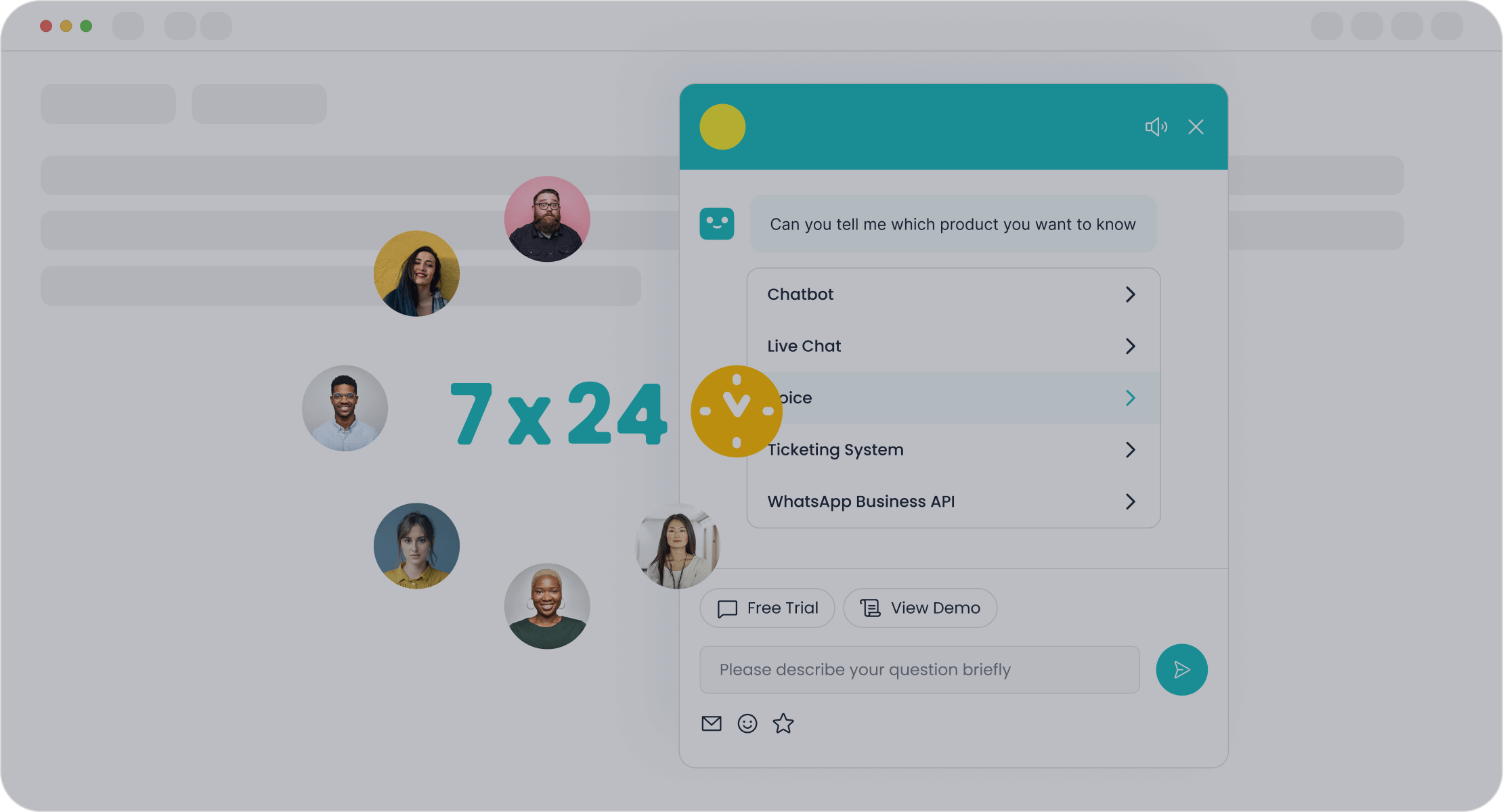
Features of Sobot Chatbot That Drive Efficiency
Efficiency is the backbone of any successful eCommerce operation, and Sobot Chatbot delivers it in spades. Its all-in-one design integrates multiple customer channels, like live chat, WhatsApp, and email, into a single platform. This means you can manage customer interactions seamlessly without juggling multiple tools.
Unlike competitors that focus on one core product, Sobot offers a comprehensive solution. It’s not just about answering questions—it’s about streamlining your entire customer service process. Plus, Sobot’s pricing is refreshingly straightforward, often costing half as much as other options, with no hidden fees.
Here’s how Sobot Chatbot drives efficiency:
- Actionable insights: You get data-driven recommendations to improve responses.
- Boosted engagement: Analyze trends to deliver personalized experiences.
- Seamless operations: Real-time analytics help you eliminate inefficiencies.
- Maximized performance: Monitor over 300 indicators to keep your chatbot running at its best.
| Performance Metric | Description |
|---|---|
| Actionable Insights | Gain deep, data-driven insights to optimize your chatbot's responses and improve efficiency. |
| Boost Customer Engagement | Deliver personalized experiences by analyzing user trends and fine-tuning your chatbot. |
| Seamless Operations | Use Chatbase analytics to streamline workflows and eliminate inefficiencies in real time. |
| Maximized Performance | Continuously monitor key metrics to ensure your chatbot performs at its peak. |
| 300+ Indicators | Provides extensive metrics to learn how consumers respond to messages for improved support. |
With Sobot, you’re not just adding a chatbot—you’re transforming how your business operates.
How Sobot Chatbot Helps Increase Online Conversion
If boosting sales is your goal, Sobot Chatbot is your secret weapon. Its smart self-service features and proactive messaging can increase conversion rates by over 20%. For example, global brands like Alibaba have seen a 35% lift in conversions using similar AI-driven tools.
Sobot doesn’t just stop at answering questions. It actively engages customers, offering personalized product recommendations based on browsing behavior. Imagine a customer hesitating over a purchase. Sobot can step in with a discount code or suggest complementary items, turning indecision into action.
Here’s what Sobot can achieve:
- Recover up to 25% of abandoned carts.
- Help brands like H&M boost sales by 15%.
- Provide tailored shopping experiences that build trust and loyalty.
By combining AI with customer insights, Sobot Chatbot ensures every interaction moves your customers closer to checkout.
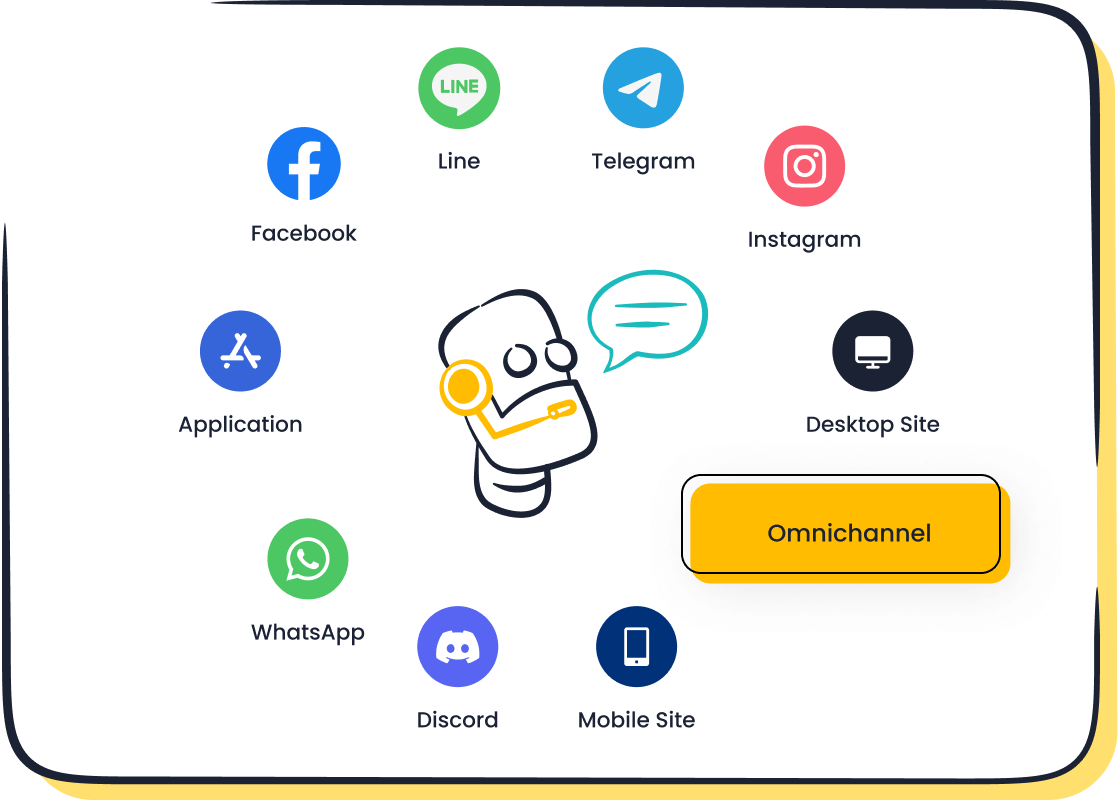
Real-World Success Stories: OPPO’s Experience with Sobot
OPPO, a global leader in smart devices, faced a challenge familiar to many eCommerce businesses: managing a surge in customer inquiries during peak shopping seasons. By partnering with Sobot, OPPO transformed its customer service.
Sobot’s chatbot handled repetitive queries, freeing human agents to focus on complex issues. This human-machine collaboration resulted in an impressive 83% chatbot resolution rate. Customers loved the faster responses, reflected in a 94% positive feedback rate.
But the benefits didn’t stop there. Sobot helped OPPO optimize its knowledge base, cutting maintenance efforts by 90%. The result? A 57% increase in repurchase rates. OPPO’s success story proves that Sobot Chatbot isn’t just a tool—it’s a game-changer for businesses aiming to scale efficiently.
Fun Fact: OPPO’s chatbot success highlights how AI can enhance both customer satisfaction and operational efficiency.
Finding the perfect AI chatbot for your eCommerce platform means aligning its features with your business goals. Chatbots like T-Mobile Austria’s Tinka and Lego’s Ralph prove how tailored solutions can boost efficiency and drive sales. Compatibility with your systems ensures smooth operations, while prioritizing customer experience builds trust and loyalty.
Sobot Chatbot stands out with its multilingual support, proactive messaging, and seamless integration. It’s a reliable partner for scaling your business. Take time to research, test options, and choose a chatbot that delivers lasting value.
Tip: A well-chosen chatbot doesn’t just save costs—it transforms your customer experience.
FAQ
What makes an AI chatbot different from traditional customer service tools?
AI chatbots use advanced technologies like Natural Language Processing (NLP) to understand and respond to customer queries. Unlike traditional tools, they offer 24/7 support, handle multiple languages, and personalize interactions based on user behavior.
Can I use an AI chatbot without coding experience?
Absolutely! Many AI chatbots, like Sobot, feature point-and-click interfaces. You can design workflows and automate tasks without writing a single line of code.
How do AI chatbots improve sales?
They engage customers with proactive messaging, personalized recommendations, and real-time assistance. Features like abandoned cart recovery and tailored promotions help convert visitors into buyers.
Are AI chatbots secure for handling customer data?
Yes, reputable chatbots prioritize security. For example, Sobot ensures GDPR compliance, encrypts data, and provides continuous backups. You can trust them to protect sensitive information.
How do I measure the success of my chatbot?
Track metrics like query resolution rate, customer satisfaction score (CSAT), and conversion rates. These indicators show how well your chatbot performs and contributes to your business goals.
See Also
Enhancing Customer Satisfaction Through Effective Chatbot Solutions
Essential Tips for Selecting Top Chatbot Software Options
Best Live Chat Tools for E-commerce Success in 2024
